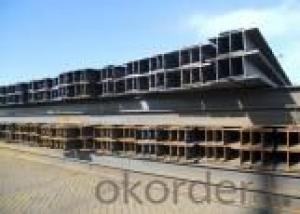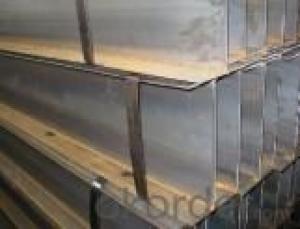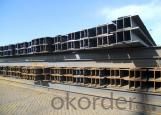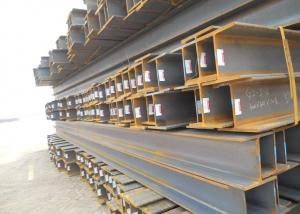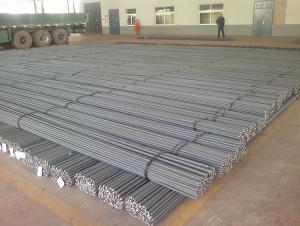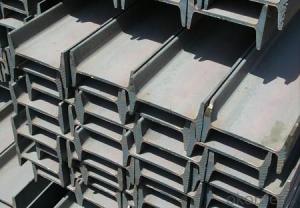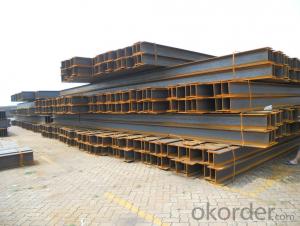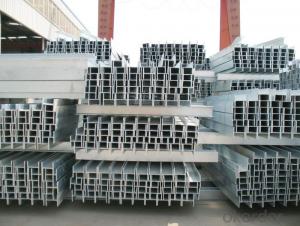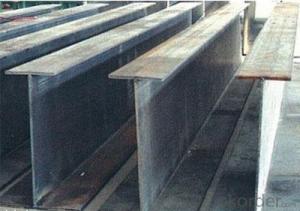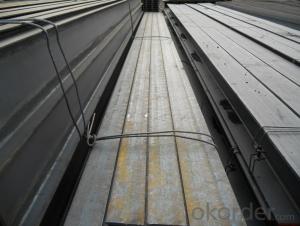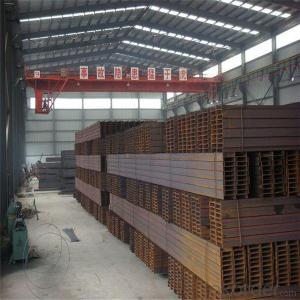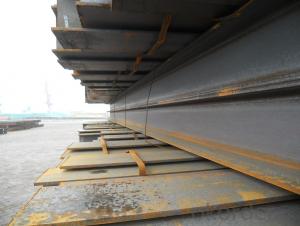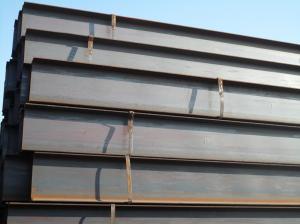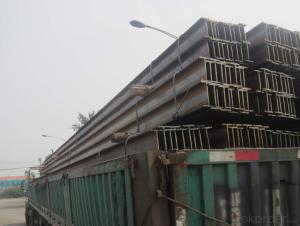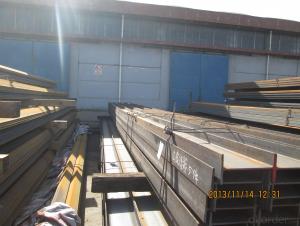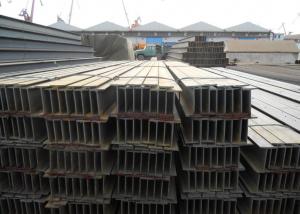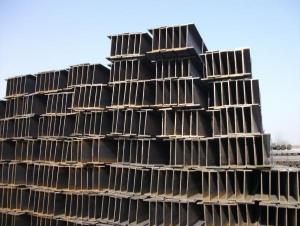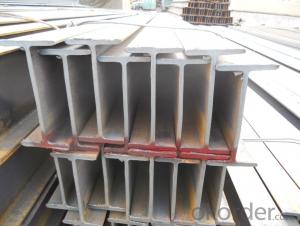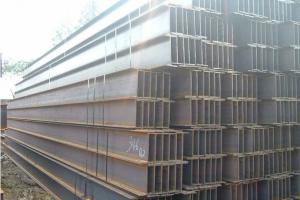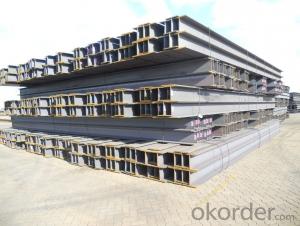H Beam Jis Standard With High Quality
- Loading Port:
- China Main Port
- Payment Terms:
- TT or LC
- Min Order Qty:
- -
- Supply Capability:
- -
OKorder Service Pledge
OKorder Financial Service
You Might Also Like
OKorder is offering H beam JIS Standard with high quality at great prices with worldwide shipping. Our supplier is a world-class manufacturer of steel, with our products utilized the world over. OKorder annually supplies products to European, North American and Asian markets. We provide quotations within 24 hours of receiving an inquiry and guarantee competitive prices.
Product Applications:
H beam JIS Standard with high quality are ideal for structural applications and are widely used in the construction of buildings and bridges, and the manufacturing, petrochemical, and transportation industries.
Product Advantages:
OKorder's H beam JIS Standard with high quality are durable, strong, and resist corrosion.
Main Product Features:
· Premium quality
· Prompt delivery & seaworthy packing (30 days after receiving deposit)
· Corrosion resistance
· Can be recycled and reused
· Mill test certification
· Professional Service
· Competitive pricing
Product Specifications:
1. Standard: JIS 3192
2. Grade: SS400 or Equivalent
3. Length: 10m, 12m as following table
4. Invoicing on theoretical weight or actual weight as customer request
5.Payment: TT or L/C
Size and Mass of H beam:
Size (mm) | Mass (Kg/m) | Size (mm) | Mass (Kg) |
100*100*6.0 | 16.9 | 148*100*6.0 | 20.7 |
125*125*6.5 | 23.6 | 150*150*7.0 | 31.1 |
150*75*5.0 | 14.0 |
1. Packing: it is nude packed in bundles by steel wire rod
2. Bundle weight: not more than 3.5MT for bulk vessel; less than 3 MT for container load
3. Marks:
Color marking: There will be color marking on both end of the bundle for the cargo delivered by bulk vessel. That makes it easily to distinguish at the destination port.
Tag mark: there will be tag mark tied up on the bundles. The information usually including supplier logo and name, product name, made in China, shipping marks and other information request by the customer.
If loading by container the marking is not needed, but we will prepare it as customer request.
FAQ:
Q1: Why buy Materials & Equipment from OKorder.com?
A1: All products offered byOKorder.com are carefully selected from China's most reliable manufacturing enterprises. Through its ISO certifications, OKorder.com adheres to the highest standards and a commitment to supply chain safety and customer satisfaction.
Q2: Can fit in the containers of 20fts the steel beams of 6M?
A2: No proble, we can put them into the containers in the form sideling.
Q3: The products are invoicing on theoritical weight or on actual weight?
A3: We can do it in both manners, according to the customers' request.
Images:
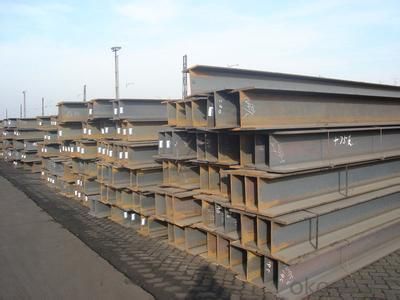

- Q: How are Steel H-Beams installed on-site?
- Steel H-Beams are typically installed on-site through a process involving hoisting and aligning. First, a crane or heavy-duty lifting equipment is used to lift the H-Beams into position. The beams are then aligned according to the required specifications, ensuring that they are level and properly oriented. Once in position, the beams are secured using various methods such as welding, bolting, or using specialized connectors. The installation process requires skilled workers and adherence to safety protocols to ensure a secure and stable structure.
- Q: Are steel H-beams suitable for buildings with heavy machinery or equipment?
- Yes, steel H-beams are suitable for buildings with heavy machinery or equipment. Steel H-beams offer excellent strength and load-bearing capacity, making them ideal for supporting heavy loads in buildings. They provide structural stability and durability, ensuring the safety and stability of the building even under significant weight and stress.
- Q: What is the difference between wide flange and I-beam steel H-beams?
- Wide flange and I-beam steel H-beams are both structural steel beams commonly used in construction. Although they have similar appearances, there are several key differences between the two. The main difference lies in their shape and dimensions. Wide flange beams, also known as W-beams, have a wider flange compared to their web height. This flange design provides better stability and strength, making wide flange beams suitable for heavy-load applications. On the other hand, I-beam steel H-beams have a narrower flange with a thicker web, giving them a more compact and efficient design. I-beams are commonly used in smaller constructions or where structural efficiency is crucial. Another difference is their weight per foot. Wide flange beams generally weigh more per foot compared to I-beam steel H-beams. This weight difference is due to the wider flange and thicker web of wide flange beams, which adds more material and increases their overall weight. The weight factor is an important consideration in construction projects, especially when determining load-bearing capacities. Furthermore, the manufacturing process for wide flange beams and I-beam steel H-beams may differ. Wide flange beams are typically produced by hot rolling, where a steel billet is heated and passed through a series of rollers to create the desired shape. I-beam steel H-beams, on the other hand, can be produced through hot rolling or by welding together individual plates or sections. This difference in manufacturing methods can impact the overall quality and consistency of the beams. In summary, the key differences between wide flange and I-beam steel H-beams lie in their shape, dimensions, weight per foot, and manufacturing process. Wide flange beams have a wider flange and are typically heavier, making them suitable for heavy-load applications. I-beam steel H-beams have a narrower flange and are generally lighter, making them more efficient for smaller constructions or where structural efficiency is crucial.
- Q: What are the cost implications of using Steel H-Beams in construction?
- The utilization of steel H-beams in construction can yield both positive and negative cost consequences. On the positive side, steel H-beams are renowned for their impressive strength-to-weight ratio, enabling the creation of lighter structures. Consequently, less steel is required, resulting in potential savings in terms of material expenses. Furthermore, steel H-beams exhibit exceptional durability and resistance to various environmental factors like corrosion, fire, and pests. This durability can lead to reduced costs associated with maintenance and replacements over the building's lifespan. Moreover, steel H-beams are typically prefabricated off-site, which can expedite construction timelines and decrease labor costs. The simplicity of installation and the availability of standardized connections also contribute to potential savings. However, on the negative side, the initial cost of steel H-beams may be higher in comparison to alternative construction materials like wood or concrete. Nevertheless, when considering the long-term benefits, such as reduced maintenance and extended lifespan, the higher initial investment may be mitigated. In addition, the price of steel is subject to market fluctuations, which can impact the cost of using steel H-beams. It is crucial to consider these potential price variations when budgeting for a construction project. Additionally, the transportation of steel H-beams can incur additional expenses, particularly if the project site is far from the steel supplier. The size and weight of these beams may require specialized equipment and extra handling, thus increasing transportation costs. In conclusion, the cost implications of employing steel H-beams in construction can be favorable due to potential savings in materials, durability, and faster construction times. Nevertheless, it is essential to carefully consider initial costs, potential price fluctuations, and transportation expenses in order to accurately assess the overall cost-effectiveness of utilizing steel H-beams in a construction project.
- Q: Can steel H-beams be used for supporting airport hangars?
- Yes, steel H-beams can be used for supporting airport hangars. Steel H-beams are commonly used in construction due to their strength and durability, making them suitable for supporting large structures like airport hangars.
- Q: How are H-beams different from other types of beams?
- H-beams, also known as hot-rolled steel beams, are a particular type of beam that differs from other types of beams due to their unique shape and structural properties. The main difference lies in their cross-sectional shape, which resembles the letter "H". This shape provides H-beams with a higher strength-to-weight ratio compared to other beam types, making them more efficient in carrying loads. One of the key advantages of H-beams is their superior load-bearing capacity. The horizontal flanges on top and bottom of the H-beam provide excellent resistance against bending and twisting forces, allowing them to support heavy loads without sagging or deforming. This makes H-beams ideal for applications that require long spans and high load-bearing capabilities, such as in the construction of bridges, skyscrapers, and large structural frameworks. Another distinguishing feature of H-beams is their versatility. Due to their unique shape, H-beams have a wide range of applications in various industries. They are commonly used in the construction sector for building frames, columns, and beams, as well as in the manufacturing industry for heavy machinery and equipment. Moreover, H-beams can be easily welded, bolted, or connected, facilitating their integration into different structural systems. Furthermore, H-beams offer cost-effective solutions in terms of material usage. Their optimized shape minimizes the amount of steel required, resulting in lower costs and reduced weight compared to other types of beams. This not only makes H-beams economical but also enhances their transportability and installation efficiency. In summary, H-beams differ from other types of beams due to their distinctive "H" shape, which grants them superior load-bearing capacity and versatility. Their ability to withstand heavy loads, ease of integration, and cost-effectiveness make them a popular choice in various construction and manufacturing applications.
- Q: What are the different types of steel H-beam connections for structures with high seismic activity?
- Ensuring the strength and stability of connections between steel H-beams is crucial in structures located in areas with high seismic activity. Various types of connections are commonly used to provide the necessary strength and stability: 1. Welded Connection: Welding is a popular method for connecting steel H-beams in seismic structures. By fusing the ends of the beams together using heat and pressure, welded connections offer high strength and rigidity, making them suitable for withstanding seismic forces. However, proper welding techniques and inspections are essential to maintain the integrity of the connection. 2. Bolted Connection: Bolted connections involve using bolts and nuts to join the steel H-beams. This method allows for easy assembly and disassembly, making it ideal for structures that may require future modifications. To enhance the seismic performance of bolted connections, high-strength bolts and appropriate washers are used. Bolts are tightened according to specific torque requirements to ensure proper clamping force. Regular inspection and maintenance are necessary to prevent loosening of the bolts over time. 3. Moment-Resisting Connection: This type of connection is specifically designed to resist the rotational forces (moments) generated during an earthquake. Moment-resisting connections can be achieved using various techniques, such as welding, bolted flange plate connections, or end-plate connections. These connections provide enhanced stiffness and strength, enabling the structure to effectively distribute seismic forces. 4. Shear Plate Connection: Shear plate connections involve using steel plates to connect the H-beams. These plates are typically welded to the flanges of the H-beams. Shear plate connections offer excellent resistance against lateral forces and can be designed to accommodate both shear and moment forces. Due to their good energy dissipation capabilities, they are commonly used in seismic structures. 5. Composite Connection: Composite connections involve connecting steel H-beams to other structural elements, such as concrete slabs or columns. By utilizing the combined strength and stiffness of steel and concrete, composite connections enhance seismic resistance. These connections can be achieved through various methods, including welding, bolting, or using connectors specifically designed for composite structures. It is important to carefully analyze and consider engineering factors when selecting the appropriate steel H-beam connection for structures located in areas with high seismic activity. Factors such as the magnitude of seismic forces, structural design requirements, and local building codes should be taken into account to ensure the safety and performance of the overall structure.
- Q: How do steel H-beams contribute to the thermal performance of a building?
- The construction industry commonly utilizes Steel H-beams, which play a crucial role in improving a building's thermal performance. These beams possess exceptional structural properties that allow for the creation of larger open spaces and reduce the need for additional supports. As a result, the building's thermal envelope is optimized by minimizing the occurrence of thermal bridges. Thermal bridges are locations within a building's structure where heat can easily escape or enter, leading to energy loss and decreased thermal efficiency. By employing steel H-beams, which possess low thermal conductivity, the risk of thermal bridging is significantly diminished. This guarantees that the building's insulation and climate control systems can function more effectively, maintaining a comfortable indoor temperature and reducing energy consumption. Furthermore, steel H-beams can be combined with other energy-efficient materials, such as insulated panels or double-glazed windows, to further enhance the building's thermal performance. These materials work in harmony with the H-beams, creating a highly insulating envelope that prevents heat transfer from inside to outside or vice versa. Moreover, steel H-beams provide support for the installation of advanced heating, ventilation, and air conditioning (HVAC) systems. By providing a strong framework, these beams enable the efficient distribution of conditioned air throughout the building, ensuring consistent thermal comfort in different areas. Additionally, steel possesses a high melting point, making it fire-resistant and contributing to the overall fire safety of the building. This characteristic, combined with the ability of steel H-beams to withstand heavy loads, provides an additional layer of protection that ensures the structural integrity of the building in case of a fire. In conclusion, steel H-beams have a significant impact on a building's thermal performance. By minimizing thermal bridging, supporting energy-efficient materials, facilitating HVAC systems, and enhancing fire safety, these beams contribute to the creation of a well-insulated and comfortable environment while reducing energy consumption and ensuring structural integrity.
- Q: Can steel H-beams be used for industrial storage facilities?
- Indeed, industrial storage facilities can utilize steel H-beams. These beams are frequently employed in construction as a result of their robustness and ability to bear heavy loads. They provide essential structural support, making them well-suited for storing substantial quantities of materials or products. Furthermore, steel H-beams possess durability and resilience against weathering, guaranteeing the longevity of the storage facility. Additionally, they offer flexibility in terms of design and layout possibilities, enabling efficient space utilization and customization to meet specific storage requirements. In conclusion, steel H-beams are a dependable and pragmatic option for the construction of industrial storage facilities.
- Q: What are the different design codes and standards for steel H-beams?
- Some of the different design codes and standards for steel H-beams include the American Institute of Steel Construction (AISC) 360, Eurocode 3, British Standards (BS) 5950, and the Canadian Standards Association (CSA) S16. These codes and standards provide guidelines and specifications for the design, fabrication, and construction of steel H-beams, ensuring structural integrity and safety.
Send your message to us
H Beam Jis Standard With High Quality
- Loading Port:
- China Main Port
- Payment Terms:
- TT or LC
- Min Order Qty:
- -
- Supply Capability:
- -
OKorder Service Pledge
OKorder Financial Service
Similar products
Hot products
Hot Searches
Related keywords
